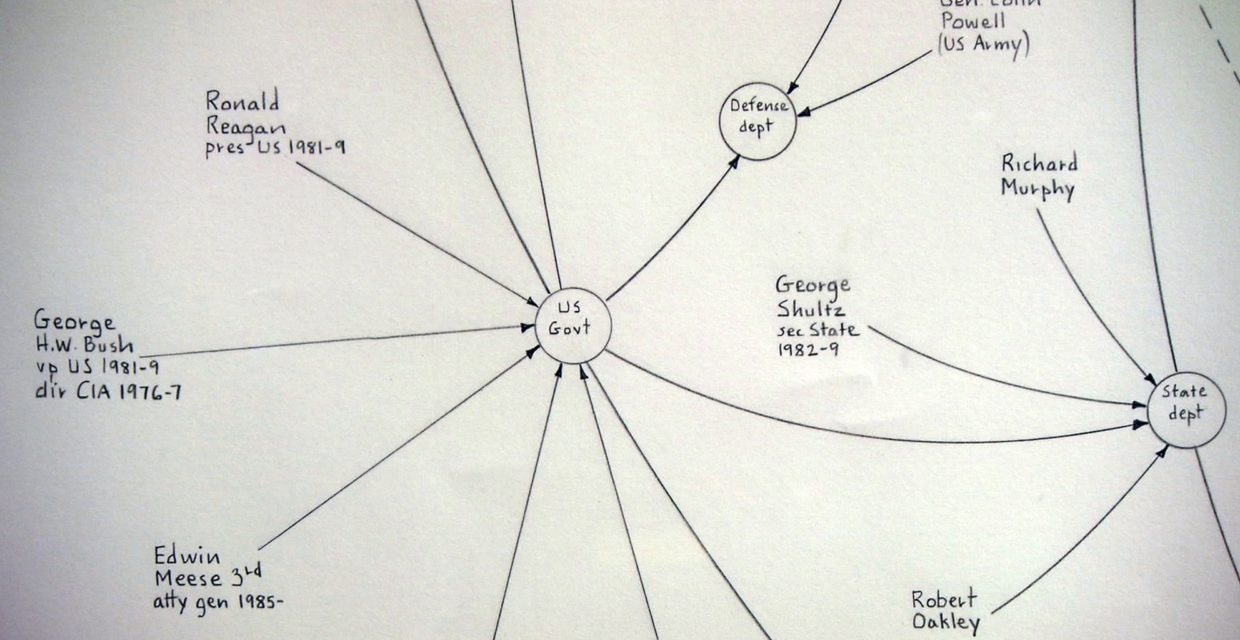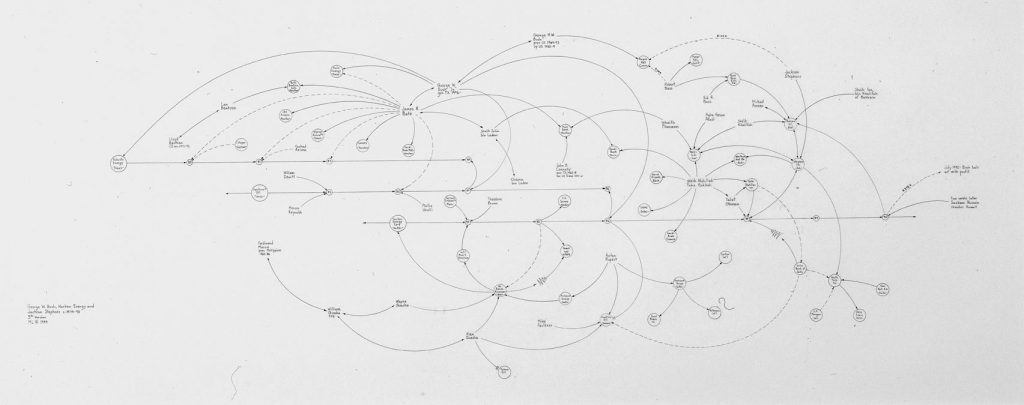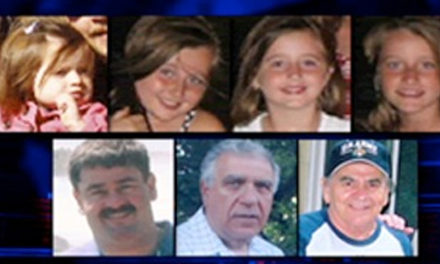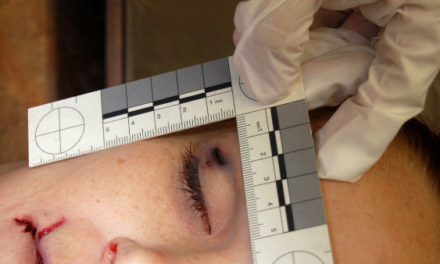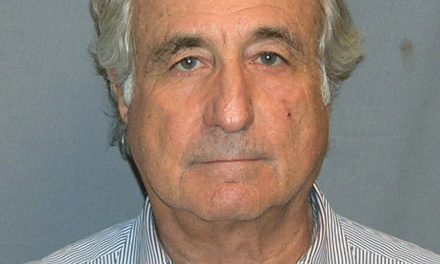Mark Lombardi
Sure, suicide occurs with every 15,000 people or so. And poor Mark Lombardi was probably just one of those people. And yet, the number of “suicides” committed by people who’ve exposed corruption, or plan too, sometimes defies those statistics. Case by case, it makes you wonder, and invites a good, close look. To scrutinize such deaths does NOT make you a crazy and paranoid “conspiracy theorist.”
Mark drew pictures about money and politics, provocative pictures, even incriminating pictures. They were diagrams of connections, with solid lines and dotted lines and annotation, of institutions and people and known scandals. The conclusions you drew from links and associations were up to you. The FBI, and other agencies of HomeLand Security took an interest, at times, in Mark’s work.
 A day before his 49th birthday, on March 22, 2000, they say he bolted his apartment from the inside and hanged himself.
A day before his 49th birthday, on March 22, 2000, they say he bolted his apartment from the inside and hanged himself.
Interest in his diagrams has grown as the years go by.
Just how much truth, and how many sordid stories, lay just beyond the diagrams Mark committed to paper? Whom had he made the most nervous?
We may never know all those answers, but the questions are more than worth asking.
Join us as we engage the Mark Lombardi file.
Lombardi’s drawings reference the drug wars, the BCCI scandal, Charles Keating and the savings and loan scandal, and Iran contra, but after 9/11, interest in his work only grew. His work, which he called “Narrative Structures,” seemed to sketch the backstory of the following decade of American foreign policy.
fGerman documentary Mareike Wegener has made the first doc about Lombardi and his work, Mark Lombardi: Death-Defying Acts of Art and Conspiracy. It’s a solid introduction to not just the finished drawings but also to Lombardi’s rigorously old-school research process, which filled thousands of note cards and file cabinets. Wegener grounds her film within the art world, using critics and art historians to situate Lombardi’s work not just within Conceptual and Neo-Conceptual art but also connecting it to centuries-old traditions of landscape painting.
Lombardi committed suicide in March, 2000, and while some conspiracy theorists and 9/11 Truthers have speculated foul play, Wegener in her film focuses on his life and his art, all the while acknowledging its continuing political relevance.”
Five Questions with Mark Lombardi: Death-Defying Acts of Art and Conspiracy Director Marieke Wegener
THE LEGEND
Conspiracy, works of art, curves and arcs, global finance and international terrorism.
Sounds like a screenplay for a new, modern-outlandish James Bond movie.
But if you’ve never heard of Mark Lombardi, you are in for a fascinating ride of intrigue. Imagine just going to the museum to relax and experience some “art” with the family, suddenly you’re immersed into mind-boggling theory of world inter-corruption.
The “narrative structures,” as Lombardi called them, were based on information he gleaned from public documents. While some saw beauty in the curves and arrows of his schematic drawings, to Lombardi, they were clues to activity in the shadows. They depicted the curious connections between the Saudis and the Bushes, the network of financial exchanges by entities from London to Riyadh, and a covert peasant uprising in Latin America. Newsweek called him “an investigative reporter whose medium just happened to be the schematic drawing.”
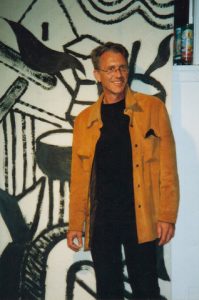 Much of Lombardi’s practice was research-based, with the information he sourced written down on index cards; some 40,000 were thought to be part of his personal archive at one point.
Much of Lombardi’s practice was research-based, with the information he sourced written down on index cards; some 40,000 were thought to be part of his personal archive at one point.
From the early 1990s, Lombardi began researching the many scandals of his time–six years before his death, he rolled out the link-analysis pencil diagrams of crime and conspiracy networks that he would become best known for.
“Lombardi is more than a conceptualist or political artist,” argued Jerry Saltz of “The Village Voice” after Lombardi’s death. “He’s a sorcerer whose drawings are crypto-mystical talismans or visual exorcisms meant to immobilize enemies, tap secret knowledge, summon power and expose demons.” But demons dislike exposure. One way or another, they will take their toll.
Patricia Goldstone has written the first comprehensive biography of the conceptual artist with “Interlock: Art, Conspiracy, and the Shadow Worlds of Mark Lombardi” (Counterpoint Press, 2015), choc full of details from those who were closest to him: family, friends, colleagues, and past loves. Goldstone weaves US historical records into the course of the artist’s life, citing scandals, political intrigue, and economic turbulence along the way.
She and many another enthusiast help us understand the seriousness, you might say the integrity in his work.
Important things to keep in mind:
*Lombardi’s sketch-representations, demonstrating the links between financial institutions, businesses, nation states, and intelligence agencies really builds on the “interlock” sketching once used by prosecutors who build anti-trust cases. He simply expanded the reach of tried-and-true methods used in the past by lawyers and forensic accountants.
*After deciding to make this his life’s work, he disappeared into the bowels of libraries for some ten years, filling thousands of cards with notes, before actually producing his first sketches for public viewing.
*He felt relatively safe from harm, noting that he only “reprossesing and rearranging” information already in the public domain,” and that those original sources were “still walking around.”
*In all those senses Lombardi was the photographic negative, the opposite, of sensationalist “conspiracy nuts.” Those scandal-flashers research something for twenty minutes on dubious sites on the internet before offering their great “expose.” Lombardi emerged from his library studies, probably pale from lack of sunlight, after thousands and thousands of hours.
For some real depth, read Goldstone’s book. Or, investing a little less time, watch her twenty-nine minute interview on YouTube.
AN OMINOUS DEATH
In March of 2000, the conceptual artist Mark Lombardi was found hanged in his studio. In the art world, speculation swirled about whether his death was suicide or murder? Why would anyone want to murder Lombardi? Some find it ominous that his intricate drawings revealed connections between George W. Bush and the bin Laden family, as well as other connections between banking, organized crime and intelligence agencies.
Only a few weeks after the Sept. 11 terrorist attacks, an FBI agent called the Whitney Museum of American Art and asked to see a drawing on exhibit there. The piece was by Mark Lombardi. Using just a pencil and a huge sheet of paper, Lombardi had created an intricate pattern of curves and arcs to illustrate the links between global finance and international terrorism.
Also in 2001, the FBI had visited the Whitney Museum of American Art and asked that it remove one of Lombardi’s artworks concerning the The Bank of Credit and Commerce International, which allegedly revealed ties to terrorist networks.
Goldstone describes the incident in the book, which troubled the artist’s mother: “It has always bothered me, just exactly how the FBI knew it was there.”
If the anecdote is accurate, we think there’s a more pregnant question–why would a government agency ask that it be removed?
Neither medical examiners nor friends could ever find any proof that it was not suicide…but doubts will always remain. One theorist, never shy about suspecting the worst about powerful forces, asked an MOMystery editor “isn’t staging a suicide, and managing to leave the door locked from the inside, easy for black-op types? Isn’t that Black Operations 101, first semester?”
But assuming Mark needed release from worldly stresses, what were they, why had they piled up just at the time his work was gaining recognition? Success-as-dealthly-depressing has been noted by suicideologists for a long time, but why, why does the psyche take that turn?
There are many sombre questions to ask in the wake of Lombardi’s demise.
THE RIGHT QUESTIONS
Some will say there’s a provocative story to Mark Lombardi’s sketches, but little else, no real mystery.
We at M.O. Mystery feel there’s a lot to penetrate here, a lot for Sherlock to puff on his pipe about.
What kind of person devotes their life to making connections between one organization and another, between groups of persons, suggesting that webs of interconnection make the world go round–as of course they do–but also attempting to make them visual, almost palpable?
What kind, perhaps as Newsweek said, an investigative reporter of a slightly different stripe?
And which of his diagrams conveyed the most meaning behind the scenes? Many a story has emerged since Lombardi’s death, sustaining his interest in those banks, those governments, those players.
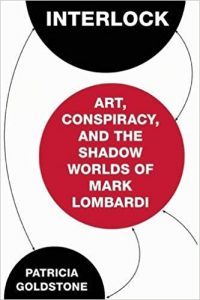 It’s fair to say each diagram is a revelation, facts and possible connections out in the open and in your face, but also a mystery, a hint down a lane at dusk that asks to be followed where it leads.
It’s fair to say each diagram is a revelation, facts and possible connections out in the open and in your face, but also a mystery, a hint down a lane at dusk that asks to be followed where it leads.
The guy was on to something.
If Lombardi believed–and we see him say it on film–that he only highlighted facts already in the public domain, what’s the big deal? Why would federal officials ask him to remove a sketch from the Whitney Museum, linking BCCI and possible terrorist actors?
That seems somehow the same, and yet different, from other government attempts at censorship, at controlling what the public knows in the interest of national security.
It’s another layer of the peeled onion, why did official investigators show so much interest in these sketched re-arrangements of public facts? Put that in Sherlock’s pipe, and smoke it.
And why, as his life’s work began to make an impact, did he commit suicide…or did he…that’s the deepest mystery of all. MO Mystery will be following this one a long time.
Mark Lombardi is dead now a number of years, but our appreciation of his story is just beginning.
THE LEGACY
This section is reserved for the still unfolding story of Mark and his meaning, in art, politics, and fully at the human level.
Did you know him, can you weigh in and reminisce?
Do you know the backstory of his last days?
And do you have any information about some of the connections he illustrated, anything that goes deeper on those mysteries?
